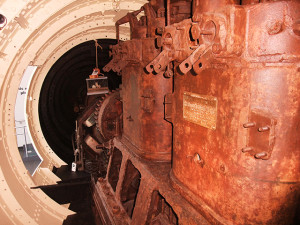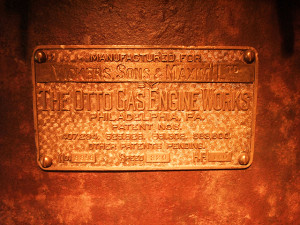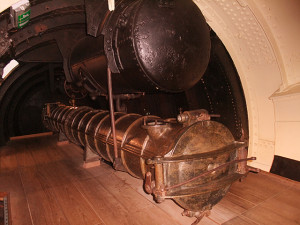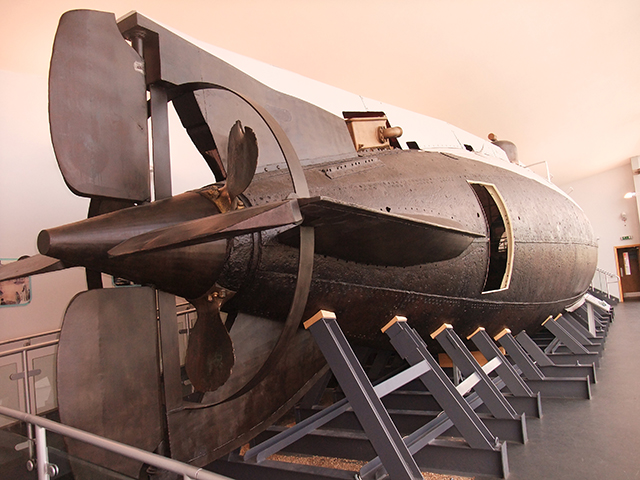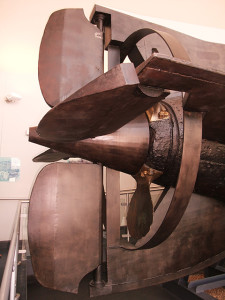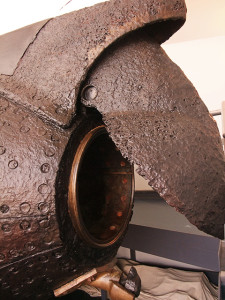News
Hoist the Jolly Roger: Diving the wreck of the Holland 5

In 1901 Admiral Sir Arthur Wilson, Controller of the Royal Navy, stated ‘Submarines are underhand, unfair and damned un-English. The crews of all Submarines should be treated as Pirates and hanged’. Soon afterwards it became a tradition that British Submarines would hoist the Jolly Roger when returning from successful missions.
 I rang Mark Beattie-Edwards, the Programme Director of the Nautical Archaeology Society, just after 7:00pm as prompted on the instruction sheet he had sent me. I had packed my car and primed my alarm clock in readiness for a 4:00am departure the very next morning. I had even made myself a Corned Beef and Tomato sandwich for the journey. 3 days worth of unsettled weather meant I was still frustratingly waiting to find out was happening. Mark had already checked the weather forecast and the decision had finally been made – we were good to go!
I rang Mark Beattie-Edwards, the Programme Director of the Nautical Archaeology Society, just after 7:00pm as prompted on the instruction sheet he had sent me. I had packed my car and primed my alarm clock in readiness for a 4:00am departure the very next morning. I had even made myself a Corned Beef and Tomato sandwich for the journey. 3 days worth of unsettled weather meant I was still frustratingly waiting to find out was happening. Mark had already checked the weather forecast and the decision had finally been made – we were good to go!
I had been invited along on a NAS outing to dive the ‘mother of all Subs’ aka the Holland 5 Submarine wreck located 6 miles off the Sussex coast near Eastbourne. When I first received the e-mail I had no idea what the Holland 5 really was. After a quick internet search I discovered that the Holland Class Submarines were the first ever Submarines to be commissioned by the Royal Navy back in 1901. From the initial order of 5 Submarines only 2 still remained. Holland 5 is the only surviving example left on the seabed. Holland 1 was salvaged in 1982 and after some extensive restoration now resides at the Submarine Museum in Gosport.
When I arrived at the Sovereign Harbour the sun was shining and the sea conditions looked quite favourable for a change. I had no idea what to expect and with the wreck being more than a 100 years old I didn’t really expect to find much of it left. Mark had chartered DIVE125 jointly skippered by Dave Ronnan and Sylvia Pryer. Dave and Sylvia’s 42 foot custom built boat was roomy enough for 12 divers including all sorts of kit configurations including a new prototype Belgian made Rebreather. All NAS outings are covered by current HSE guidelines so divers have to wear an alternative/redundant air supply in the form of a Pony Cylinder or a Twinset. The plan was to do the first dive on the Holland 5 and then a second shallower dive on the Norman’s Bay wreck. DIVE125 had an onboard compressor for anyone requiring a refill.
The Holland Class was designed by John Philip Holland of Irish-American decent. The first Submarine came off the production line on October 2nd 1901. Each Submarine took around 8 months to build and cost £35,000. There was no launching ceremony as the Submarines were deemed experimental and the Navy were trying to keep their new weapon a secret.
The 19.5 metre long Submarines had a maximum range of 20 miles underwater and a top speed of 7 knots. They could even dive to 30 metres. Capt Bacon, who was in charge of operations, is reported to have said ‘these Submarines would be a terror to any ship’. Initial trials showed that the Submarines could get within 1000 yards of their target without any alarm being raised. A pay load of up to 3 x 18 inch Torpedoes would cause some serious damage to enemy shipping.
The Submarines were never used in ‘active’ service. The Dogger Bank incident in October 1905 was the closest that they ever got to firing a Torpedo at a live target. This involved the Russian Fleet mistakenly attacking a number of British fishing trawlers. But the Holland Submarines were recalled back to harbour when the dispute was resolved by diplomatic means. On the 8th August 1912 the now obsolete Holland 5 was being towed to Sheerness in Kent (probably to be scrapped) when she foundered and sank. There was no loss of life.
Mark said that they found Holland 5 in 2000 but its true identity was not confirmed until April 2001. Once the initial survey work had been completed the Submarine was designated under the protection of wrecks act. This basically states that divers are not allowed to explore the wreck site without first obtaining permission from the NAS. Divers don’t have to be underwater Archaeologists or have special qualifications. Any individual diver or club can make a booking. Contact Mark for a list of available dates.
I was impressed how quickly DIVE125 found the little Submarine. Just to make sure the shotline was sitting right next door to the wreck Dave went down the line first to check its position. Mark offered to show me around the mini Submarine and act as ‘model’ for any pictures I might take. We waited until all the other divers had gone into the water before kitting up. With so many divers kicking around on such a small site I didn’t hold out much hope for pictures but I was pleasantly surprised when we reached the seabed at 31 metres. The bottom composition looked more like gravel than fine silt so the underwater visibility topped out at an impressive 8 metres. Maybe the other divers had heeded my request (demand) to be careful with their fin kicks?
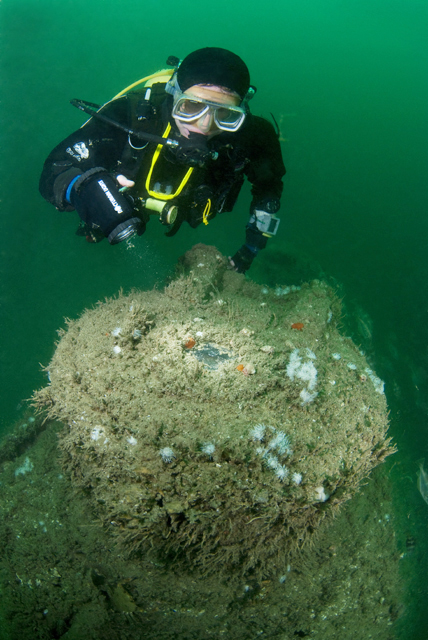 The Submarine was lying upright and looked in remarkably good condition considering its age. Apparently the hull was made from a special high grade metal which has helped to keep it well preserved. Mark finned along the cigar shaped hull to the Conning Tower. I was expecting to see a massive tube like structure sticking out but instead there was a short stubby 1-2 metre ‘tower’ with a hinged hatch on top. A small glass window had been fitted into the centre of the hatch and it was still possible to take a look inside. The Holland Submarines were fitted with one of the first ever periscopes but I couldn’t find anything that resembled one.
The Submarine was lying upright and looked in remarkably good condition considering its age. Apparently the hull was made from a special high grade metal which has helped to keep it well preserved. Mark finned along the cigar shaped hull to the Conning Tower. I was expecting to see a massive tube like structure sticking out but instead there was a short stubby 1-2 metre ‘tower’ with a hinged hatch on top. A small glass window had been fitted into the centre of the hatch and it was still possible to take a look inside. The Holland Submarines were fitted with one of the first ever periscopes but I couldn’t find anything that resembled one.
After 5 minutes worth of photo taking we moved towards the stern passing over the square shaped exhaust box. The Submarines were fitted with a 160hp petrol engine and a 70hp electric motor which powered the single 3 bladed Propeller. A cage of white Mice used to be kept by the engine to warn the crew of any escaping Petrol fumes or exhaust gases. This had been a ‘design upgrade’ owing to the fact that on earlier trial runs there had been an explosion on Holland 1 seriously injuring 2 of the crew.
Some of the flimsier metal work had either corroded away all simply fallen off. The ‘Mickey Mouse’ eared propeller was originally surrounded by metalwork connected to 4 big paddle sized rudders but they had now parted from the main structure and were lying on the seabed.
We had saved enough time to visit the bow which seemed to be a bone of contention just lately. All I could see was a huge gaping hole. This was the Torpedo tube minus its protective hatch. Mark said that due to bad weather they hadn’t dived on the wreck for more than a year. When they returned the Torpedo tube hatch was missing. English Heritage had reported the incident to the Sussex Police but so far no one had come forward. I couldn’t understand why someone would want to remove the hatchway – it must have weighed a ton. It wasn’t exactly mantle piece sized! There was supposed to be a big Conger living inside the tube but I didn’t see anything. To be honest I didn’t get time to stick my head inside and check it out thoroughly. Divers can easily circumnavigate the Submarine 2 or 3 times over in one dive. There was plenty of Pouting and Pollack on the wreck and even a row of Lobsters nestled together on the seabed.
For our shallower second dive Mark guided me around the Norman’s Bay wreck site. Mark said that they are still not certain about the wreck’s true identity. They had not yet found anything of significance that proved beyond doubt that it was either HMS Resolution, which sank during a storm in 1703, or a Dutch warship lost during the Battle of Beachy Head in 1690. Lack of funds had hindered a full site examination as of yet.
The NAS have set up a ‘trail’ for divers to follow. This includes a waterproof information sheet showing points of interest. I followed Mark down the main yellow marker buoy to the seabed. Luckily there was a guideline to follow as underwater visibility was only 2-3 metres. On the day this was a really silty site with absolutely no chance of getting any pictures. So far they have found 42 cannons, a huge anchor, musket balls and various timbers. Some of the Cannons were ‘welded’ together forming archways.
All in all it had been well worth the early start. I had enjoyed a nice relaxed day on the boat, had 2 good dives and met most of the NAS staff. The Holland 5 Submarine is an important piece of naval history and seeing Holland 1 on display in the Royal Naval Museum at Gosport had made the experience even more complete. It gave me a much better perspective of the Submarines size and shape and what it should look like with all the bits in place (including the Torpedo tube hatch). The Submarine has been fully restored including the inside. Conditions looked really cramped and claustrophobic, especially for a crew of 9. There were no dividing walls so everything was in the same compartment including the noisy engine. Early Submariners must have cursed John Philip Holland. At least they had the sense to fit a toilet. I guess there was no chance of constipation with 3 big Torpedoes sitting right next door!
Contact Information
DIVE 125
Dave and Sylvia
E-mail: David.ronnan@btinternet.com
Website: www.dive125.co.uk
Tel no: 07764 585353
Nautical Archaeology Society (NAS)
Mark Beattie-Edwards – Programme Director
Fort Cumberland
Fort Cumberland Road
Portsmouth
PO4 9LD
Tel No: 023 9281 8419
E-mail: Mark@nauticalarchaeologysociety.org
Website: www.nauticalarchaeologysociety.org
The Royal Navy Submarine Museum
Haslar Road,
Gosport
PO12 2AS
E-mail: enquiries@submarine-museum.co.uk
Website: www.submarine-museum.co.uk
Tel No: 023 9251 0354
Gear News
Introducing the TR-80, IR-50 and CS-30 Regulators from DYNAMICNORD

Whether you are a beginner or a professional diver – with the three new main regulators from DYNAMICNORD, everyone will find their favourite regulator. They all look super stylish.
Excellent performance with the TR-80
Quality and performance are the be-all and end-all for regulators. It is not for nothing that the TR stands for Tec Reg. The innovative design of the TR-80 guarantees absolute reliability – even in ice-cold waters.

Perfect breathing effort at 0.8 J/l / certified for diving in waters below 10 degrees / structural design made of solid brass for best cold protection / membrane-compensated design with dry seal of the first stage / reduced exhalation effort thanks to optimized exhalation membrane and bubble deflector / adjustable Venturi (dive/predive) and adjustment knob for individual inhalation comfort / innovative design of the front cover prevents free-flow in strong currents or when diving with scooters / design made of sandblasted brass, matt chrome finish / 2 HP and 4 LP outlets / mouthpiece made of high-quality, anti-allergic silicone for maximum comfort.


Amazing underwater adventures with the IR-50
The IR-50 is the top regulator for advanced and experienced divers. Natural breathing is the essence of this regulator.

Ideal breathing effort at 0.8 J/l /certified for diving in waters below 10 degrees / compensated membrane / adjustable venturi (dive/predive) and adjustment knob for individual inhalation comfort/ outlet valve and deflector for minimum exhalation effort and reduction of bubbles on the face / design made of sandblasted brass, matt chrome finish / 2 HP and 4 NP outlets / mouthpiece made of high-quality, anti-allergic silicone for maximum comfort.


The Workhorse – our CS-30
For diving centres and diving beginners – the workhorse stands for strong construction, reliability and robustness. Perfect for your training.

Optimal breathing effort at 0.8 J/l /recommended for diving in waters above 10 degrees / non-compensated piston / adjustable venturi (dive/predive) / outlet valve and deflector for minimum exhalation effort and reduction of bubbles on the face / design made of sandblasted brass, matt chrome finish / 1 HP and 3 NP outlets / mouthpiece made of high-quality, anti-allergic silicone for maximum comfort.


Octopus OP-30
The OP-30 is the ideal addition to all DYNAMICNORD regulators. It is identical in construction to the CS-30.

The TR-80, IR-50, CS-30 (DIN & INT) regulators and the Octopus OP-30 are available from DYNAMICNORD dealers and in the online store.
DYNAMICNORD – Your Outdoor Companion.
Marine Life & Conservation
Paul Watson Released as Denmark Blocks Japan’s Extradition Bid

Renowned anti-whaling activist Paul Watson has been released from custody in Greenland after spending five months in detention. Denmark’s Justice Ministry rejected Japan’s request for his extradition, citing insufficient guarantees that his time already served in custody would be credited against any potential sentence.
The 74-year-old Canadian-American was arrested on July 21 in Nuuk, Greenland’s capital, when his ship docked to refuel. His arrest was based on a 2012 Japanese warrant related to a 2010 encounter in Antarctic waters. Japan alleged Watson obstructed operations and caused damage to a whaling research ship during efforts to disrupt illegal whaling. Watson has consistently denied these claims, maintaining his commitment to marine conservation.
Denmark, which oversees extradition matters for Greenland, concluded that while the legal conditions for extradition were met, the lack of assurances from Japan regarding time-served credit made extradition untenable.
In a video shared by his foundation, Watson expressed gratitude and relief, saying, “After five months, it’s good to be out… and good to know they’re not sending me to Japan.” He added that the most difficult part of his time in custody was being separated from his two young sons.
Watson is a pioneering figure in marine conservation, known for founding the Captain Paul Watson Foundation in 2022 after decades of activism with the Sea Shepherd Conservation Society. His bold efforts to defend marine life have earned him widespread support, including from celebrities and conservationists. His work has also been featured in the acclaimed reality TV series Whale Wars.
Watson’s lawyer, Jonas Christoffersen, praised the decision, stating, “We are happy and relieved that Paul Watson is now free.” He added that Watson is eager to reunite with his family and continue his vital work.
The arrest occurred while Watson’s vessel, the M/Y John Paul DeJoria, was en route to the North Pacific with a team of 26 volunteers to intercept a Japanese whaling ship. His foundation described the arrest as politically motivated and emphasized that Watson’s actions were focused on ending illegal whaling practices.
Japan resumed commercial whaling in 2019 after leaving the International Whaling Commission, asserting that whale meat is a cultural tradition. Conservationists, however, continue to challenge these practices, highlighting their impact on marine ecosystems.
Despite the challenges, Watson remains steadfast in his mission to protect marine life and bring attention to whaling practices. His dedication to ocean conservation has made him a globally respected advocate for the environment.
-

 News2 months ago
News2 months agoIconic SS United States to become the World’s Largest Artificial Reef
-

 News3 months ago
News3 months agoBook Review – 52 Assignments: Underwater Photography
-

 Gear News3 months ago
Gear News3 months agoDYNAMICNORD – New German diving brand enters the British market
-

 News3 months ago
News3 months agoExploring Cenote El Pit: A Diver’s Dream
-

 Gear News3 months ago
Gear News3 months agoTry BARE drysuits (and maybe even win one!) this Friday with Sea & Sea at North West Dive Fest
-

 Marine Life & Conservation3 months ago
Marine Life & Conservation3 months agoBook Review: Coral Triangle Cameos
-

 Blogs2 months ago
Blogs2 months agoDive the Egyptian Red Sea this Autumn with Regaldive
-

 News3 months ago
News3 months ago2024 Ocean Art Underwater Photo Competition Announced


